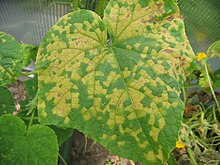Wrong mildew
The downy mildew is since the mid-19th century in agriculture and horticulture in Europe dreaded plant disease. It was first described in 1878 under the name Plasmo Para . Today the different types of downy mildew are grouped under the order Peronosporales of the egg fungi (phylogenetically these do not belong to the fungi!). In contrast to powdery mildew , a grayish-bluish fungal lawn develops on the underside of the leaf.
The infection occurs either as a primary infection in spring through oospores , which can overwinter in the soil, or through zoospores , which are formed by the infected primary herds. The freely moving spores (zoospores) penetrate through stomata into the host tissue, where they form the fungal network ( hyphae ) between the cells (intercellular) . The fungi extract nutrients from the plant via nutritional organs (haustoria), which are introduced into the living cells, thereby damaging them. For reproduction, hyphae grow out of the stomata and form branched fruit bodies (sporangia carriers). The loss of nutrients causes the infected leaves to turn yellow and fall off. Downy mildew spreads mainly under warm, humid conditions in the field and also in greenhouse crops.
Great economic importance among the peronosporales of downy mildew of grapevine ( Plasmopara viticola ), the late blight of potato ( Phytophthora infestans ) and tobacco blue mold ( Peronospora hyoscyami f. Sp. Tabacina ). Sugar beet , lettuce , cabbage species and roses are also endangered under warm and humid site conditions . Downy mildew in cucumbers can lead to total crop failure in the greenhouse . Downy mildew is also important in sunflowers , parsley ( Plasmopara crustosa ) and hops .
Until the second half of the 20th century, only copper compounds were available to combat downy mildew. Because of the damage to soil life when using this metal, its use has been restricted. In current crop production , mainly synthetically produced systemic fungicides and contact fungicides are used prophylactically . An effective means is the use of phosphonic acid (no longer permitted in organic farming since 2014). The plant protection warning service plays a special role in the control of powdery mildew in agriculture and viticulture. This is issued by state plant protection offices and scientific institutes during the vegetation period and provides regional information on when control measures are to be taken in outdoor crops due to the amount of precipitation and temperatures. Peronospora warning devices are also used to reduce the use of fungicides.
In addition, special research efforts are being carried out on the one hand to use natural substances to trigger resistance to downy mildew in crops and on the other hand to breed powdery mildew-resistant plant varieties.
literature
- Frank Brändle: Isolation of an elicitor protein from sporangia of Plasmopara halstedii, the downy mildew of the sunflower. 2005, DNB 982788762 .
- Heinrich Buchenauer: Investigations into the mode of action and the behavior of various fungicides in fungi and cultivated plants. Habil.-Schr. Bonn 1979, DNB 910830576 .
- Birte Deil: Studies on the epidemiology of downy mildew on spinach as the basis for the development of a prognosis model. 2003, DNB 970868235 .
- Iris Föller: Investigations of camelina for diseases with special consideration of downy mildew. 2000, DNB 962711993 .
- Rudolf Heitefuss among other things: Plant diseases and pests in agriculture. 4th edition. Frankfurt 2000, ISBN 3-7690-0576-7 .
- Horst Lyr , Heinrich Buchenauer: Modern selective fungicides; properties, applications, mechanisms of action. Jena 1987, ISBN 3-334-00034-6 .
- Claus Otto among others: joint project; Increase of the plant's own defense mechanisms in agricultural crops by induction of resistance; Sub-project development and provision of resistance-inducing plant strengtheners against powdery mildew and downy mildew. Jena 2000, OCLC 248910714 .
Web links
- Rolf Blaich: Viticulture and vines in the flora of Central Europe. An online textbook University of Hohenheim
- Agricultural Industry Association; Online magazine for crop protection (keyword powdery mildew)
- Forecast calculation for downy mildew and oidium for vines - VITIMETEO
Individual evidence
- ↑ Wine knowledge: vine diseases . Retrieved September 14, 2014.
